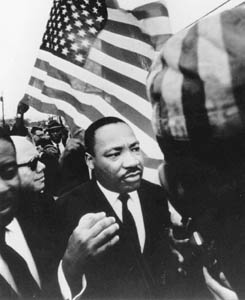![[Metroactive News&Issues]](/gifs/news468.gif)
[ Santa Cruz Week | SantaCruz Home | Archives ]
King for a Day
Every schoolchild knows about Martin Luther King Jr.'s famous dream--but that was only one part of his revolutionary message
By Stephen Kessler
FIFTEEN YEARS since its original commemoration as a national holiday, how many Americans remember that the Martin Luther King Day bill was signed into law by Ronald Reagan, the most reactionary and racially insensitive president of our time?
Yielding to public and congressional pressure in the mid-'80s, President Reagan--whose famously symbolic visit to the Nazi cemetery at Bitburg, Germany, endeared him to racists everywhere--ironically became the reluctant advocate of our official celebration of Dr. King and his progressive legacy. This curious twist of history testified to the moral power of King's humanistic vision of tolerance and equality, however far humanity has yet to travel to reach those goals.
King's eventual opposition to the Vietnam War turned Lyndon Johnson and other liberals against him--a black man campaigning for integration was one thing, but at the time it seemed rather uppity for the Nobel Peace Prize recipient to be lecturing the white power structure on foreign policy--and ultimately led to his murder.
Now, many of the people who resisted King's influence during his lifetime have embraced the King holiday as an opportunity to whitewash the image of a nonthreatening black leader whose trademarks were nonviolence and some kind of harmless "dream." Safely enshrined as a historic statue, the reality of King's militancy, his leadership in labor struggles and the antiwar movement, his acknowledgment of the connections between war abroad and poverty at home are easily ignored.
Yet King is such a contemporary figure--assassinated in 1968 at the age of 39--that many people remember firsthand what he was doing and saying.
Retired UCSC sociology professor Hardy Frye, who worked in the Deep South in the 1960s as an organizer with the Student Nonviolent Coordinating Committee (SNCC)--often working in concert with Dr. King and his organization, the Southern Christian Leadership Conference (SCLC)--has called the King holiday an homage to "all the people who worked in the movement."
After retirement, Frye joined the Peace Corps and now works in Guyana, Africa. In a conversation held some time before he left, he remembered that the SNCC and the SCLC often differed over strategy or tactics, but that King was universally admired.
It was a combination of brilliant intellect, personal magnetism and oratorical eloquence--integrated with a deep commitment to spiritual values--that swept King into the leadership of a movement that mobilized thousands of people and made him a national hero. He skillfully used his own celebrity and the tactic of nonviolent confrontation to focus the attention of U.S. media on the struggle for civil rights.
King would often use the drama of a local crisis--in Montgomery, in Selma, in Chicago, in Memphis--to gain national publicity for his cause. SNCC had a different strategy, Frye explained, whereby "you build a political organization at the grassroots level and you work your way out of a job by strengthening people to run their own communities. We didn't believe you bring NBC, ABC and all the cameras and churches in to push through national legislation.
"Not that we didn't think national legislation was important," he added, "but we were more in tune with people's daily lives than perhaps Martin was--because of who he was and how much traveling he had to do."
Of course, it was in part the traveling, the expanding contact with different people in different communities that helped King understand the larger implications of black people's struggle for freedom, and to see that struggle in an international context. As early as 1963 King was referring in speeches to "our brothers and sisters in Africa and Asia who are moving swiftly toward independence, while we are moving slowly toward a hamburger and cup of coffee at a lunch counter."
The solid religious basis for King's activism prefigured what was to become known in Latin America as liberation theology. The power of nonviolence, he insisted, was in its ability to disarm the opponent from a position of moral strength, dignity, courage and compassion. It was a political extension of the revolutionary message of Jesus.
King's Christian critique of a supposedly Christian culture exposed the contradictions between America's ideals and its reality. As he drew the connections between racism, poverty, economic exploitation and militarism, his call for change grew more comprehensive. In the last year of his life he was saying that "a nation that continues year after year to spend more money on military defense than on programs of social uplift is approaching spiritual death."
Unable to ignore the implications of nuclear weapons, he observed that the choice was no longer "between violence and nonviolence, it is either nonviolence and nonexistence."
These were fairly radical things to be saying in 1967 and '68--so radical, in fact, and so dangerous to the status quo that this visionary individual had to be crucified for his teachings. Whoever it was that ordered his murder, King's execution served to decapitate for the time being a growing movement throughout this country for social/spiritual/political transformation.
Part of that transformation has occurred, as Frye pointed out, through the integration of numerous black activists of the King era "inside the margins of the system," where they have some impact as standard-bearers of a humane legislative agenda.
A subtler aspect of the transformation has been the courage of individuals inspired by his example to change themselves and thereby change reality. Though there may be a long way to go before King's famous dream is realized, his birthday can serve as a beacon of commitment for those on the path of peace and liberation.
Copyright © Metro Publishing Inc. Maintained by Boulevards New Media.
![]()

Photograph by Flip Schulke
From the January 16-23, 2002 issue of Metro Santa Cruz.